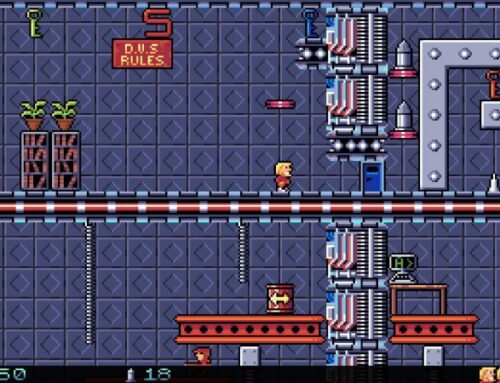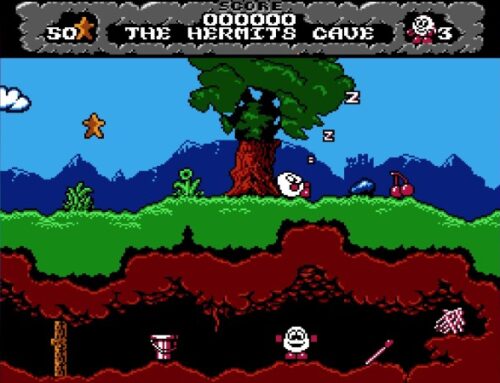I tend to think of myself as having got into role-playing games with Final Fantasy VII on the PlayStation — and indeed, that’s where my interest in the genre became a somewhat all-encompassing part of my overall gaming identity. But thinking back, I was actually introduced to the genre much earlier — much earlier — through games like Epyx’s Gateway to Apshai, which I first experienced on Atari 8-bit.
Gateway to Apshai is ostensibly a prequel to the company’s well-known Temple of Apshai entry in its Dunjonquest series, but rather than simply being a new adventure in the same engine as most of the other Dunjonquest games were — or indeed a complete remake of said engine, as the later Temple of Apshai Trilogy was — it took a rather different approach to its stablemate. Specifically, it kept some of the elements that made role-playing games fun — gathering treasure and equipment, gradually growing more powerful — and combined it with the simple, score-chasing fun of arcade games.

In Gateway to Apshai, you’re supposedly a descendent of some heroic type, and you’re forced (somewhat against your will, if the introductory blurb in the manual is any indication) to go and explore a series of dungeons in the hope of reopening the mysterious Temple of Apshai. Given the fact that Temple of Apshai primarily concerns dealing with the swarms of monsters that swarm out of said Temple, this is obviously a very bad idea, but when did that ever stop an adventurous type?
In fact, there’s no real way to “beat” Gateway to Apshai; the game’s levels simply loop when you reach the end of them, and with a choice of 16 different dungeons to explore on each level, there’s plenty of game here to keep you busy — particularly as you’ll probably die long before you reach that “loop point”.
Instead, your only real aim in Gateway to Apshai is simply to survive as long as possible and score as many points as you can. The former is achieved by battling monsters, avoiding or dealing with traps and procuring equipment with which to better protect yourself, and the latter is accomplished by collecting treasure scattered in coffers around the various dungeons.

Most treasures are worth points, and the materials that the treasures are made from affect their overall value. Lead items tend to be pretty much worthless, for example, while golden items are, of course, very valuable. The treasure isn’t directly used for anything — your score isn’t “experience” or anything — but it does give you an idea of how well you’re doing, as well as somewhat tying in to the game’s progression system.
There’s no exit from each level of Gateway to Apshai; instead, you can either keep exploring the level until the timer runs out, at which point you’ll be forced onto the next, or at any point you can choose to advance to the next level. At this point, some or all of your stats will increase according to the proportion of the treasures you gathered on the level you just left; this also increases your maximum possible life, as your maximum hit points are equal to the sum of your other statistics.
Interacting with Gateway to Apshai works well and, unlike Temple of Apshai, does not require the memorisation of a keyboard full of actions. Instead, the majority of your actions are mapped to the function keys on the computer (Start, Select and Option on Atari 8-bit, for example) and the chosen action is then performed by pressing the fire button on the controller.

For example, using the Atari 8-bit version as an example, pressing Start once chooses the “Fight” option, which allows you to swing your currently equipped melee weapon by pressing the fire button. Find a door, and a tap of the Select button brings up the “Keys” option, allowing you to open the door by pressing the fire button. Spot a suspicious-looking treasure chest, and pressing Select several times allows you to search for traps with another tap of the fire button. And after finding a piece of equipment or consumable item, pressing Option allows you to cycle through the things you are carrying and equip it with, you guessed it, the fire button.
Although occasionally cumbersome, the fact you can leave an action “readied” indefinitely means that Gateway to Apshai doesn’t really get bogged down at any point. You can, for example, leave the Fight option active for most of the time just in case you stumble across a monster; alternatively, if you’re paranoid about traps, leave the Locate Trap option active and spam it to your heart’s content — there are no cooldowns to worry about here.
Gateway to Apshai’s dungeons are implemented with an early example of a “fog of war” system. The maps aren’t randomised, but their layouts are hidden until you proceed into each new “room”. Once revealed, a room or corridor remains on screen until you lose a life — yes, you have lives in this, like an arcade game — at which point you return to the start point of the level, with all your mapping progress forgotten. You can also locate map scrolls, which immediately reveal the entire layout of the level to you — though there’s no “overall map” function allowing you to view the whole floor at once; this simply opens up all the rooms.

Blocking your path to treasure hunting stardom is a varied cast of monsters who become increasingly powerful and dangerous as you progress through the game. Most of them have fairly simple behaviour, typically following you from room to room, but there’s some variation in terms of their speed and overall power levels. Bats can generally be swept aside with a single slash, for example, while Ogres will be very dangerous the first time you stumble across them — they’re a good time to start making use of the bows and arrows you’ll doubtless find on your quest!
Gateway to Apshai is, as you might expect from a 1983 release in a fledgling genre, rather simple by modern standards — but in many ways that is what helps it to shine so brightly even today. It’s still a massive amount of fun to play, you see; there’s a timeless appeal to exploring mysterious dungeons, fighting off powerful foes and attempting to make it out with as much loot as possible — and the “score attack” nature of the game makes it eminently replayable.
So if you’ve never given it a go for yourself, rest assured that it comes highly recommended from the Retrounite Adventurer’s Guild — and what’s more, you can start your adventures not only on the Atari 8-bit, but also on the Commodore 64 and ColecoVision.

So what are you waiting for? Throw open the gates of Apshai, and see how many shiny goodies you can acquire before your inevitable bloody demise!
Screenshots from the Atari 8-bit version.




